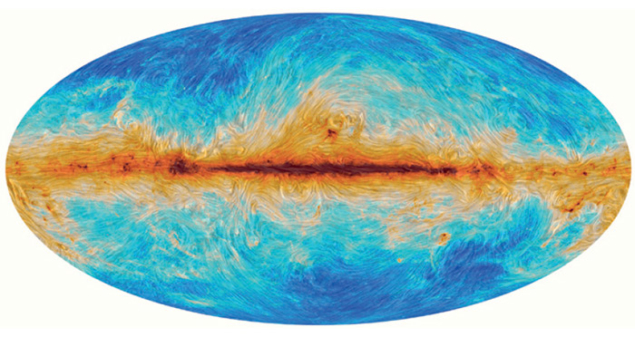
Image credit: ESA and the Planck Collaboration.
The release of the full mission data of ESA’s Planck spacecraft is a milestone for cosmology. Despite the high quality of the data – including, for the first time, polarization observations – and the thorough analysis by the Planck collaboration, this event had little impact in the community and in public. Rather than strengthening the case for new physics, it confirms with high accuracy the standard model of cosmology, disfavours the existence of a light sterile neutrino, and turns down the hope for a dark-matter origin of the positron excess in cosmic rays.
Planck is the third generation of missions dedicated to the observation of the cosmic microwave background (CMB). This “first light” – freed 380,000 years after the Big Bang – provides key information on the universe as a whole, its fundamental constituents and its past and future evolution. Planck builds on the detection of the first large-scale CMB anisotropies by the Cosmic Background Explorer (COBE) in the early 1990s, and the much sharper view provided by NASA’s Wilkinson Microwave Anisotropy Probe (WMAP) in the following decade (CERN Courier May 2006 p12). Planck’s strength is that, by extending the wavelength coverage to higher frequencies than measured by WMAP, it is better able to disentangle foreground emission from the Milky Way and other galaxies.
The Planck collaboration – including individuals from more than 100 scientific institutes in Europe, the US and Canada – released the first data of the mission in March 2013, together with 31 scientific papers (CERN Courier May 2013 p12). Already then, the results confirmed with higher accuracy the relative abundance of the cosmic ingredients, namely ordinary (baryonic) matter, cold dark matter (CDM) and a cosmological constant (Λ), as derived by WMAP (CERN Courier May 2008 p8). The new Planck results confirm that these components sum up to the critical density corresponding to a flat universe with no global curvature, and yield only small changes to the relative abundances in this standard ΛCDM cosmology.
The press release from ESA emphasizes the result that the re-ionization of the universe by the first stars took place some 550 million years after the Big Bang, which is some 100 million years later than previously assumed for this end of the “Dark Ages”. There are, however, other interesting results on more fundamental physics. Planck further limits the sum of the active neutrino masses to be below 0.194 eV, and constrains the effective number of light, relativistic neutrinos, Neff, to be 3.04±0.33 (both at 95% CL with external constraints). This strongly disfavours the existence of an additional fourth quasi-massless neutrino, which could have been a sterile (“right-handed”) one, but it does not exclude the possibility of heavier (> 1–10 eV) sterile neutrinos.
Another interesting result coming from CMB polarization measurements is a constraint on dark-matter annihilation, which could have contributed to the re-ionization of the universe at the beginning of the “Dark Ages”. The derived upper limit almost entirely excludes the dark-matter interpretation – a neutralino with a mass of the order of 1 TeV – of the positron excess measured by the Alpha Magnetic Spectrometer (CERN Courier November 2014 p6). Finally, the combined analysis of Planck data with the measurements by BICEP2 and the Keck array on the curly B-modes of the CMB polarization confirms that at least most, if not all, of the signal is from galactic dust in the Galaxy (CERN Courier November 2014 p15), therefore disproving the claim for primordial gravitational waves from inflation (CERN Courier May 2014 p13).








